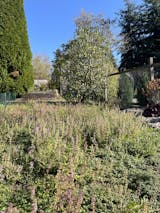30 Winterberry Holly - Ilex Verticillata Shrub Seeds
Regular price
$14.99
Sale
Winterberry Holly - Ilex Verticillata Shrub Seeds (Hardy, Showy)
Winterberry is a deciduous holly native to eastern North America where it typically occurs in swamps, damp thickets, low woods, and along ponds and streams. It is a slow-growing, large deciduous shrub or small tree with an upright rounded habit that typically grows 3 to 12 feet tall.
The trunk is short and generally, branches close to the ground and the stout, upright, spreading branches bear slender twiggy branchlets, producing a rounded crown, 8 to12 feet across. Winterberry often suckers and grows in a multi-stemmed clump and may form a thicket of erect stems.
Leaves are elliptic to obovate, toothed, dark green, and 2 to 3 inches long. Fall color is usually negligible, but in some years leaves may turn attractive shades of maroon. If the leaves haven't fallen by the first hard frost, they turn black, hence the common name, "Black Alder." Relatively inconspicuous greenish-white flowers appear in the leaf axils in late spring.
Flowers, if properly pollinated, give way to a crop of glossy bright red 1/4 inch berries in late summer to fall. Berries are quite showy and will persist throughout the winter (hence the common name) and often into early spring. Berries provide considerable impact and interest to the winter landscape.
A Winterberry, loaded with bright red berries on slender twigs is one of the prettiest shrubs in winter. It's especially attractive standing proudly with snow on its branches. It is a great shrub for wet areas in the landscape. Use it in shrub borders or in masses for its winter berry display. Winterberry is a good choice for an unclipped hedge. It looks great in front of evergreens. Many kinds of birds eat the fruits and often the shrubs are stripped bare before Christmas.
Winterberry branches with their showy red berries are often used as Christmas decorations and there is a commercial industry cultivating the plants for that purpose. Use them dry (don't put them in water) and they will keep for months indoors.
Name: Winterberry
Other Common Names: Winterberry Holly / Coralberry / Michigan Holly / Canada Holly / Candian Holly / Fever Bush / Black Alder / False Alder / Common Winterberry
Scientific Name: Ilex Verticillata Syn. Var. Cyclophylla, Var. Padifolia, Var. Fastigiata, & Var. Tenuifolia / Ilex Bronxensis / Ilex Fastigiata
Color: White Flowers / Red Berries
Plant Seeds: Seeds Requires Warm Stratification Followed by Cold Stratification or They Can Be Sown Outside in Spring for Germination the following Spring.
Bloom Time: Flowers - May to July / Berries - Late Summer to Fall Through Winter
Hardiness Zone: 3 - 9
Plant Height: 6 - 10' (Up to 16')
Plant Spacing: 6 - 12'
Light Requirements: Sun - Part Shade
Soil & Water Preferences: Average - Moist













